
Organic reaction mechanisms. 1998 / 12
.pdf
12 Elimination Reactions |
399 |
affected by the aromatic resonance energy of the β-substituent, becomes slightly more product like with a larger degree of proton transfer, more negative charge development at the β-carbon, and a greater extent of leaving group departure as the substituent is changed from phenyl to thienyl to furyl (relative rates 1:1.1:0.6); this trend is evidenced by the corresponding increase in kH/kD, ρ and |βlg| values.25 The following
respective values were determined for (31) and (32): kH/kD = 8.2 ± 0.1 and 8.8 ± 0.2, ρ = 1.22 ± 0.19 and 1.87 ± 0.05, βlg = −0.43 ± .01 and −0.55 ± 0.1, H = = 5.9 ±
0.1 and 6.5 ± 0.1 kcal mol−1, and S= = −28.5 ± 0.3 cal mol−1 |
K−1 |
and −29.0 ± |
1.5 cal mol−1 K−1. |
|
|
An E2 mechanism has been proposed to account for |
the |
kinetics of |
formation of 3-azabicyclo[3.3.0]oct-2-ene on dehydrohalogenation of N -chloro-3- azabicyclo[3.3.0]octane in alkaline medium.26
The vicarious nucleophilic substitution of carboand hetero-cyclic nitroarene hydrogen by a hydroxyl group, on reaction with silylhydroperoxide anions, has been shown to proceed via nucleophilic addition of ROO− followed by base induced elimination of ROH by an E2-type mechanism; the required orientation of the hydroxylation can be controlled by the conditions selected.27
Although no rates have been determined, the results of semiquantitative experiments involving competition between displacement of hydrogen and halogen have been interpreted in terms of the following equation for the VNS process:
|
+ RO2− |
|
k1 |
|
|
|
|
kE[B] |
|||||
HArNO2 |
|
|
|
RO2(H)Ar |
|
NO2− |
|
O |
|
Ar |
|
NO2− |
|
|
|
|
k−1 |
|
|
|
|
−ROH |
|||||
v = kobs [HArNO2][RO2−] |
|
where kobs = k1kE[B]/(k−1 + kE[B]) |
|||||||||||
The ratio of products (36) and (37) from VNS of hydrogen (PH) and substitution of halogen (PX), respectively (Scheme 4), will depend on the strength and concentration of base, provided that the elimination is a kinetically important step in the VNS reaction, namely PH/PX = k1kE[B]/k−1kX. The influence of base will decrease until a constant value PH/PX = k1/kX is reached as kE[B] k−1. This has been demonstrated for 4-chloronitrobenzene, which undergoes exclusive substitution of chlorine unless strong base is present to favour the VNS process. The deuterium isotope effect for VNS hydroxylation by But OOH, determined as the ratio of H versus D substitution of 1-deutero-2,4-dinitrobenzene, varied from 7.0 ± 0.3 to 0.98 ± 0.01 as the base in NH3 was changed from NaOH to But OK; the former value is consistent with a rate determining E2 process.
Solvolytic Reactions
Salt effects on monomolecular heterolysis reactions (SN1, E1, F 1, solvolysis) have been reviewed28 and the effects of salts on the rate of dehydrobromination of 3- bromocyclohexene have been interpreted.29 The regiochemistry and stereochemistry
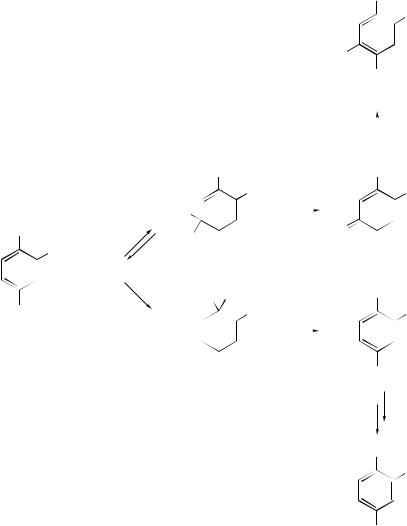
400 |
|
|
|
|
|
|
Organic Reaction Mechanisms 1998 |
|||||||||
|
|
|
|
|
|
|
|
|
|
X |
||||||
|
|
|
|
|
|
|
|
|
|
|
|
|
|
|
|
Z |
|
|
|
|
|
|
|
|
|
|
|
|
|
|
|
|
|
|
|
|
|
|
|
|
|
|
|
|
|
|
|
|
|
|
|
|
|
|
|
|
|
|
|
|
HO |
||||||
|
|
|
|
|
|
|
|
|
|
NO2 |
||||||
|
|
|
|
|
|
|
|
|
|
(36) |
|
|||||
|
|
|
|
|
|
|
|
|
|
|
||||||
|
|
|
|
|
|
|
|
|
|
−H+ |
|
|||||
|
|
|
|
X |
|
|
X |
|||||||||
|
|
|
|
|
|
|
Z |
kE[B] |
|
|
|
|
|
|
Z |
|
|
|
|
H |
|
|
|
|
|
|
|
|
|||||
|
|
|
|
|
|
|
|
|
|
|
||||||
|
|
|
|
|
|
|
|
|
|
|
|
|
||||
X |
k1 |
|
−ROH |
O |
|
|
|
|
|
|
||||||
ROO |
|
|
|
|
|
|
|
|
|
|||||||
|
|
|
|
|
|
|
|
|
|
|||||||
|
|
|
|
|
|
|
||||||||||
|
Z |
|
|
|
|
|
|
|
|
|
|
|
||||
|
|
|
NO2− |
|
|
NO2− |
||||||||||
|
+ RO |
− |
k−1 |
|
|
|
|
|
|
|
|
|
||||
|
|
|
|
|
|
|
|
|
|
|||||||
|
|
2 |
|
|
|
|
|
|
|
|
|
|
|
|
|
|
|
|
kX |
|
X OOR |
|
|
OOR |
|||||||||
NO2 |
|
|
|
|
Z |
|
|
|
|
|
|
|
|
Z |
||
|
|
|
|
|
−X− |
|
|
|
|
|
|
|
||||
(35) |
|
|
|
|
|
|
|
|
|
|
|
|
|
|
||
|
|
|
|
|
|
|
|
|
|
|
|
|
|
|||
|
|
|
|
|
|
|
fast |
|
|
|
|
|
|
|
||
|
|
|
|
|
|
|
|
|
|
|
|
|
|
|
||
|
|
|
|
|
|
|
|
|
|
|
|
|
|
|||
|
|
|
|
|
|
|
|
|
|
|
|
|
|
|
|
|
|
|
|
|
NO2− |
|
|
NO2 |
|||||||||
OH
Z
NO2
(37)
SCHEME 4
of elimination of water from tertiary alcohols (38) of ring size (n + 1) = 5–16 have been reported (see Table 1).30 The reaction is presumed to proceed via an intermediate carbenium ion which then deprotonates to give isomeric alkenes (40) and (E)- or (Z)-(41). The behaviour of the medium sized rings can be explained in terms of I-strain.
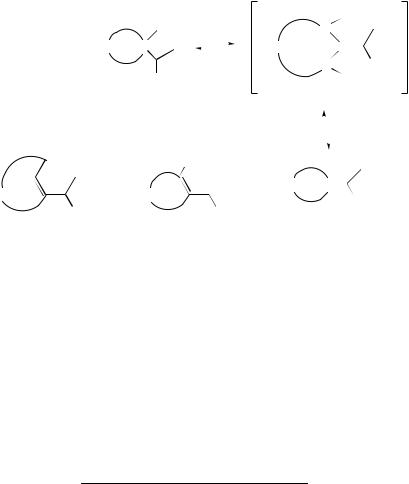
12 Elimination Reactions |
|
|
|
|
|
|
|
|
|
|
|
|
|
401 |
||
|
|
|
|
|
|
|
|
|
|
|
H |
|
||||
|
|
|
OH |
|
|
|
|
|
|
|
|
|
|
H |
||
|
|
|
|
|
H+ |
|
|
C |
|
|||||||
|
|
(H2C)n |
C |
|
|
(H2C)n−2 |
|
|
+ C |
H |
||||||
|
|
|
|
|
|
|
|
|
||||||||
|
|
|
H2O |
|
|
|||||||||||
|
|
|
|
|
|
|
|
C |
CO2Et |
|||||||
|
|
|
|
|
|
|
|
|
|
|
||||||
|
|
|
CO2Et |
|
|
|
|
|
|
|
|
|
|
H |
|
|
|
|
|
|
|
|
|
|
|
|
|
|
|
|
|||
|
|
|
(38) |
|
|
|
|
|
|
|
H |
|
||||
|
|
|
|
|
|
|
|
|
|
|
|
|
|
|
|
|
|
|
|
|
|
|
|
|
|
|
|
|
|
|
|
|
|
|
|
|
|
|
|
|
|
|
|
|
|
|
|
|
|
|
|
|
|
|
|
|
|
|
|
|
|
H+ |
|
|
|
|
|
|
|
|
|
H |
|
|
|
|
|
|
|
|
||||
H |
+ |
|
|
|
|
|
|
+ (H2C)n |
C |
|
|
|
||||
(H2C)n−1 |
(H2C)n−1 |
|
|
|
|
|
|
|
CO2Et |
|||||||
|
|
|
|
|
|
|
|
|
|
|
|
|
|
|||
|
CO2Et |
|
|
|
CO2Et |
|
|
|
|
|
|
|
||||
|
|
|
|
|
|
|
|
|
|
|
|
|||||
(Z)-(41) |
|
|
(E)-(41) |
|
|
(40) |
|
|
||||||||
|
|
TABLE 1. Distribution (%) of alkenes formed |
|
|
|
|
|
|
||||||||
|
|
from (38) |
|
|
|
|
|
|
|
|
|
|
|
|
|
|
|
|
|
|
|
|
|
|
|
|
|
|
|
||||
|
|
n + 1 |
(40) |
(E)-(41) |
(Z)-(41) |
|
|
|
|
|
|
|||||
|
|
5 |
34 |
66 |
|
|
0 |
|
|
|
|
|
|
|
||
|
6 |
0 |
100 |
|
|
0 |
|
|
|
|
|
|
|
|||
|
7 |
20 |
80 |
|
|
0 |
|
|
|
|
|
|
|
|||
|
8 |
8 |
92 |
|
|
0 |
|
|
|
|
|
|
|
|||
|
9 |
2 |
96 |
|
|
2 |
|
|
|
|
|
|
|
|||
|
10 |
0 |
100 |
|
|
0 |
|
|
|
|
|
|
|
|||
|
11 |
1 |
89 |
|
|
10 |
|
|
|
|
|
|
|
|||
|
12 |
1 |
86 |
|
|
13 |
|
|
|
|
|
|
|
|||
|
13 |
4 |
68 |
|
|
28 |
|
|
|
|
|
|
|
|||
|
|
14a |
15 |
60 |
|
|
25 |
|
|
|
|
|
|
|
||
|
15 |
28 |
54 |
|
|
18 |
|
|
|
|
|
|
|
|||
|
16 |
7 |
73 |
|
|
20 |
|
|
|
|
|
|
|
|||
aResults calculated by extrapolation.
Specific acid-catalysed solvolysis of 1-methoxy-1,4-dihydronaphthalene or 2- methoxy-1,2-dihydronaphthalene in 25% acetonitrile in water has been found to yield mainly the elimination product, naphthalene, along with a small amount of 2-hydroxy-1,2-dihydronaphthalene, there being no trace of either the 1-hydroxy-1,4-
dihydronaphthalene or the rearranged ether.31 The nucleophilic selectivity, k |
N3 |
/k |
HOH = |
||||
2.1 × 10 |
4 |
|
|
|
|
||
|
, between added azide ion and solvent |
water has been estimated for the |
|||||
relatively stable (kw = 1 × 107 |
s−1) intermediate |
benzallylic carbocation for which |
|||||
the barrier to dehydronation is |
unusually low (ke = 1.6 × 1010 s−1), as |
evidenced |
|||||
by the large elimination-to-substitution ratio with solvent water as base/nucleophile. The kinetics of acid-catalysed solvolysis of 1-hydroxy-1,4-dihydronaphthalene and 2-hydroxy-1,2-dihydronaphthalene have also been studied.
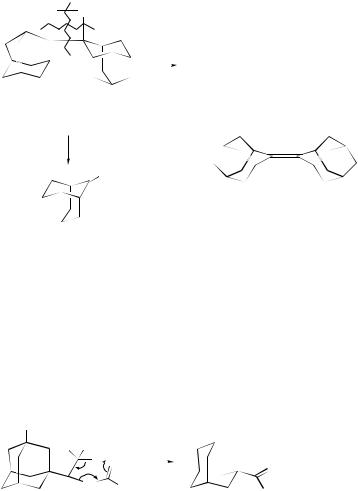
402 |
Organic Reaction Mechanisms 1998 |
Pyrolytic Reactions
Cycloreversions
The retro-Diels–Alder reaction has been reviewed.32 A fully concerted cyclic transition state has been proposed for conrotatory opening of cyclobutenes, in order to account for the low activation entropy and unexpected activation volume of ca −2 to −3 cm3 mol−1.33
2 + 2-Cycloreversions of a 1,2-disilacyclobutane (42) and a 1,2-digermacyclobutane (43) have been induced in solution both thermally and photochemically; fragmentation of sterically congested (42) follows Scheme 5 paths a and b, respectively; fragmentation of (43) yields (46) (which photodissociates to 48) in each case.34
(Me3Si)2M M(SiMe3)2
|
b |
|
|
|
|
(Me3Si)2M=M(SiMe3)2/(Me3Si)2M: |
|
|
|
||
|
|
(45) M = Si |
(47) M = Si |
(42) M = Si |
|
(46) M = Ge |
(48) M = Ge |
(43) M = Ge |
|
|
+ |
|
|
|
|
a
M(SiMe3)2
(49)
(44) M = Si
SCHEME 5
Acid Derivatives
Further evidence has been reported in favour of the loss of neutrals (even-electron) from even-electron anions by a charge-remote process.35 Thus, the parent (M − H)− ion (50), in which the 1- and 3-substituents on adamantane can neither interact through bonds nor approach through space, has been found to fragment by exclusive loss of HCO2D. The corresponding carboxylate cation (M − H)+, generated by charge reversal of anion (50), has been shown to behave likewise.
CO2− |
|
|
CO2− |
D D |
|
|
+ HCO2D |
D O |
|
|
|
|
|
||
|
|
|
CD2 |
O |
H |
|
CD3 |
CD3 |
|
||
|
|
||
(50) |
|
(51) |
|

12 Elimination Reactions |
403 |
Unimolecular pyrolysis of the tautomers of monothioformic acid (two conformers of thioland two conformers of thiono-) have been studied by ab initio methods with STO-3 G and 6–31 G basis sets.36 The barrier heights for dehydrogenation (via a four-centre transition state) and dehydrogensulfidation (via a three-centre transition state) of thiol formic acid are 67.47 and 67.09 kcal mol−1, respectively. Dehydration of s-cis-HCSOH occurs via a three-centre transition state with an activation energy of 81.18 kcal mol−1; this is much greater than for dehydration of the s-trans form, which occurs via a four-centre transition state with a barrier of only 68.83 kcal mol−1.
Results of HF/3–21 G theoretical studies of gas-phase dehydration of α-hydroxy acids suggest that the reaction is favoured by electron-donating substituents via a three-membered ring intermediate formed via a five-membered ring transition state; a three-membered ring transition state governs formation of product in the second step.37
Certain perfluoro esters (52) (incapable of the eliminative fragmentation, with β- hydrogen migration, commonly displayed by hydrocarbon esters) have been shown to decompose at elevated temperature (230–250 ◦C).38 AM1 semiempirical calculations suggest that a four-membered transition state (53) featuring transfer of α-fluorine to the carbonyl carbon is involved; this is consistent with the negative entropy of activation and relatively high activation energy.
O |
F |
F |
|
|
|
O |
Rf2 |
|
‡ |
O |
F |
|
|
Rf2 |
||||||
|
|
|
|
|
|
|||||||||||||||
|
|
|
|
|
|
|
|
|
||||||||||||
|
|
|
|
Rf2 |
|
|
|
F |
|
|
|
|
|
|
|
|
+ |
|
|
|
|
|
|
|
|
|
|
|
|
|
|
|
|
|
|
|
|
|
|||
Rf1 |
O |
|
|
Rf1 |
O |
F |
|
|
|
Rf1 |
|
|
F |
|
O |
|||||
|
|
|
(52) |
|
|
|
|
(53) |
|
|
|
|
|
|
|
|
|
|
|
|
Further theoretical study of the mechanism of decomposition of β-propiolactone and β-butyrolactone, to form CO2 and ethene or propene, respectively, has concluded that the process can best be described as asynchronous and concerted.39 Calculations also suggest that concerted processes are preferred for both decarbonylation and decarboxylation of η-thiobutyrolactone.40
Direct evidence has been reported for the formation of methoxyvinyland methylthiovinyl-(carboxy)ketenes (55c and 55d) upon flash vacuum thermolysis of Meldrum’s acid derivatives (54c) and (54d), respectively;41 the intermediates decarboxylate readily to give (56c) and (56d), respectively, and are more transient than those obtained previously from (54a,b).
First-order kinetics have been reported for gas-phase thermal decomposition of nitroethyl carboxylates to give nitroethylene and the corresponding aliphatic acid.42
Nitrogen Compounds
Activation parameters have been determined for eliminative thermal decomposition of hexahydro-1,3,5-trinitro-1,3,5-triazine and related compounds, under high pressure in dilute solution.43 The negative activation volumes, low enthalpies of activation,
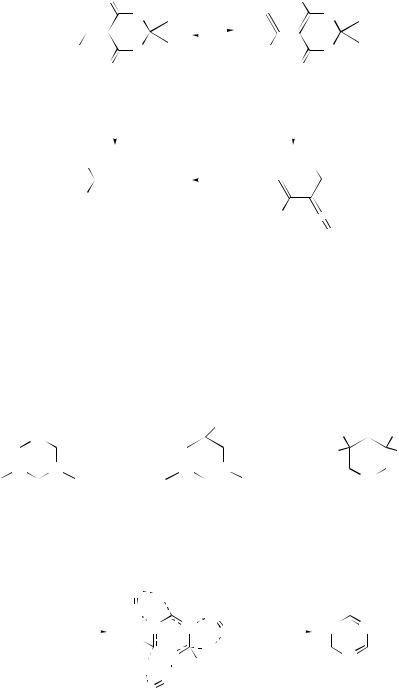
404 |
|
|
|
|
|
|
|
|
|
|
|
|
Organic Reaction Mechanisms 1998 |
|||||||||
|
|
O |
|
|
|
|
|
|
|
|
|
HO |
|
|
||||||||
|
|
|
|
|
|
|
|
|
|
|
|
|||||||||||
Me |
|
O |
∆ |
|
|
|
|
|
|
O |
|
|||||||||||
|
|
|
|
|
|
|
|
|
|
|
|
|
|
|
|
|
|
|
|
|
||
|
|
|
|
|
|
|
|
|
|
|
|
|
|
|
|
|
|
|
|
|
|
|
R |
|
O |
|
|
|
R |
|
|
O |
|
||||||||||||
|
|
|
|
|
|
|
||||||||||||||||
|
|
O |
|
|
|
|
|
|
|
|
|
|
O |
|
|
|||||||
|
|
|
|
|
|
|
|
|
|
|
|
|
|
|||||||||
(54) |
|
|
|
|
|
|
|
|
|
|
|
|
|
|
|
|
||||||
|
|
∆ |
|
−Me2CO |
|
|
|
|
∆ |
|
−Me2CO |
|||||||||||
|
|
|
|
|
|
|
|
|||||||||||||||
|
|
|
−CO2 |
|
|
|
|
|
||||||||||||||
|
|
|
|
|
|
|
|
|
|
|
|
|
|
|
|
|
|
|||||
Me |
|
|
|
|
|
∆ |
|
|
H |
|
O |
|||||||||||
|
|
|
|
|
|
|||||||||||||||||
|
|
|
|
|
• |
|
• |
|
O |
|
|
|
|
|
|
|
O |
|||||
|
|
|
|
|
|
|
|
|
|
|
|
|
|
|
|
|||||||
|
|
|
|
|
|
−CO2 |
|
|
|
|
|
|
|
|||||||||
R |
|
|
|
|
|
|
|
|
|
|
|
|
|
|
|
|||||||
|
|
|
|
|
|
|
|
|
|
|
|
|
|
|
|
|
||||||
(56) |
|
|
|
|
|
|
|
|
R |
|
• |
|||||||||||
|
|
|
|
|
|
|
|
|
|
|
|
|
|
|
|
|
|
|
O |
|||
|
|
|
|
|
|
|
|
|
|
|
|
|
|
|
|
|
(55) |
|
|
|
||
a; R = H, b; R = Me, c; R = MeO, d; R = MeS
order of thermal stability and detection of aromatic products suggest that these cyclic nitramines and nitrosamines decompose through elimination of HNO2 or HNO by a non-homolytic pathway which is dependent on reaction conditions and structural features. The order of stability (58a > 57b > 57a > 58b > 59) is consistent with the expected decrease in acidities of the methylene hydrogens.
|
Z |
|
|
|
X |
|
Y |
|
|
|
|
|
|||||
|
|
|
|
|
|
|
|
|
|
W |
|
W |
|||||
|
N |
|
|
|
|
|
|
|
|
|
|
||||||
|
|
|
|
|
|
|
|
|
|
|
|
|
|
||||
|
|
|
|
|
|
|
|
|
|
|
|
|
|
W |
|
W |
|
|
N N |
|
|
NO2 |
N |
|
N |
|
|
|
N |
||||||
Z |
|
|
Z |
|
|
|
|
|
NO2 |
|
|
|
|||||
|
|
|
|
|
|
|
|
|
|
||||||||
|
|
|
|
|
|
|
|
|
|
|
|
|
|
|
|
|
|
|
|
|
|
|
|
|
|
|
|
|
|
|
|
|
|
NO2 |
|
(57a) Z = NO2 |
|
|
(58a) X = Me, Y = NO2 |
|
(59) W = NO2 |
||||||||||||
(57b) Z = NO |
|
|
(58b) X = NO2, Y = NO2 |
|
|
|
|
|
|||||||||
|
|
|
|
|
|
O H |
H |
|
|
|
‡ |
|
|
|
|
|
|
|
|
|
|
|
|
|
d+ |
|
|
|
|
|
|||||
|
|
|
|
|
|
|
|
|
|
|
|
|
|||||
|
|
|
|
|
|
N |
|
|
|
|
|
|
|
|
|||
|
|
|
|
|
|
|
|
|
N |
|
|
|
|
|
|
||
|
|
|
|
|
|
|
N N |
|
|
|
N |
N + 3HNO |
|||||
e.g. |
(57b) |
|
|
|
H |
|
O d− |
|
|
||||||||
|
|
|
|
|
|||||||||||||
|
|
d− |
|
|
|
||||||||||||
|
|
|
|
|
|
|
H |
N |
H |
Hd+ |
|
|
|
|
N |
||
|
|
|
|
|
|
|
N |
|
|
|
|
|
|
|
|
||
|
|
|
|
|
|
|
O |
|
|
|
|
|
|
|
|
|
|
|
|
|
|
|
|
|
|
|
|
|
|
|
|
|
|
|
|

12 Elimination Reactions |
405 |
Formation of 2H -azirines by thermal decomposition of vinyl azides has been shown to exhibit small entropy of activation and insensitivity to solvent polarity; acyclic vinyl azides decompose more readily than analogous cyclic ones and it is advantageous to have a hydrogen atom cis to the azido group (E-are more reactive than Z-isomers).44 These results and the linear correlation found for ring-substituent effects on decomposition of α-styryl azides are consistent with a nonconcerted mechanism in which elimination of nitrogen and cyclization into a three-membered ring proceeds synchronously.
It is clear from a study of thermal and radical-induced decompositions of N - alkoxycarbonyldihydropyridines that radical processes are of minor importance, and that pyridine formation is probably a consequence of 1,2-elimination of formate (Scheme 6).45 It has also been concluded that the rate of 1,4-elimination of formate from N -alkoxycarbonyl-1,4-dihydropyridines at higher temperatures is too rapid to be explained by a homolytic process.
|
H |
|
∆ |
|
|
|
H |
|
|
|
|
|
H |
|
|
O |
||||
|
|
|
|
|
|
|
|
|
|
|
|
|
|
|
|
+ |
|
|
R |
|
|
|
|
|
|
|
|
|
|
|
|
|
|
|
|
|
|
|
|||
|
|
|
|
|
|
|
|
|
|
|
|
|
|
|
|
|||||
|
|
|
|
|
|
|
|
|
|
|
|
|
|
|
|
|
|
|
|
|
N |
|
|
|
O |
|
|
N |
|
|
O |
|
|
|
|
|
N |
O |
|||
|
|
|
|
R |
|
|
|
|
|
|
R |
|
|
|
|
|||||
|
|
|
|
|
|
|
|
|
|
|
|
|
||||||||
|
|
|
|
|
|
|
|
|
|
|
|
|
|
|
|
|
|
|
|
|
|
O |
|
|
|
|
|
O |
|
|
|
|
|
|
|
|
|
||||
SCHEME 6
The thermodynamics and shock-tube kinetics of pyrolysis of azetidine, in argon at high dilution, have been compared with those for trimethylene oxide, sulfide and imine.46
Thermochemical parameters estimated by semiempirical AM1 calculations have been found to support the proposal that isobutene formation on gas-phase thermolysis of N -methyl-N -phenyl-tert -butylsulfenamide and morpholinyl-tert -butylsulfenamide occurs by a unimolecular mechanism involving a four-centre cyclic transition state and co-formation of the corresponding thiohydroxylamines.47
Kinetics and mechanisms of gas-phase pyrolysis of sulfonyl hydrazones and their oxime analogues have been reported for the first time;48 it is proposed that cyanoarene formation arises in each case via a six-membered transition state (60). The lower limit
Ar
N  C
C
X H
O
S
O G
(60)
e.g. Ar = Ph, G = p-Tol, X = O or NH
406 |
Organic Reaction Mechanisms 1998 |
for rate enhancement on replacing the hydrazone N−NH bond by the oxime N−O bond is 6–9 × 104 and the Hammett ρ value for the hydrazones is negligible (ca 0.01).
Other Pyrolytic Reactions
Comparison of results of single-pulse shock-tube experiments with those from an earlier study suggest that the existing rate expression for HF elimination from 1,1,1- trifluoroethane may need to be re-evaluated.49
The transition state for elimination of HF from hydrofluorocarbons has been probed by determining threshold energies and unimolecular rate constants for such reactions of chemically activated CF3CH2CH3 and CF3CH2CF3.50 Chemically activated CF3CH2CH3* containing 95 and 101 kcal mol−1 internal energy can be produced by combination of CF3CH•2 with CH•3, or CF3• with CH3CH•2, respectively. The unimolecular elimination rate constants calculated from RRKM theory were fitted to the experimental values in order to obtain threshold energies, E0, of 73 kcal mol−1 for CF3CH2CF3 and 62 kcal mol−1 for CF3CH2CH3; these, on comparison with those for CF3CH3 and CF3CH2Cl, show that replacement of H of CF3CH3by a methyl substituent lowers E0 by ca 5 kcal mol−1. The chlorine and fluorine substituents have the same effect on E0 as a CF3 group. Approach to the transition state for HF elimination apparently involves a flow of electron density from the departing hydrogen to the β-carbon, and from the β- to the α-carbon and to the α-carbon from its substituents; most of the incoming electron-density is passed from the α-carbon to the departing fluorine. Thus, electron-withdrawing substituents on either carbon raise E0 because they hinder the flow of electron density.
Results of a PEPICO study of the dissociation dynamics of 2-bromobutane ions have been analysed with tunnelling-corrected RRKM statistical theory using vibrational frequencies obtained from ab initio MO calculations.51 It has been concluded that the slow rate of loss of HBr, to form the but-2-ene ion, occurs via a concerted mechanism in which tunnelling is a feature of the proton transfer.
Theoretical predictions, based on AM1 MO theory, for gas-phase elimination reactions of 3-chloropropanoic and 2-chlorobutanoic acids are consistent with experimental results; four-, five-, and six-membered transition states have been discussed.52
o-Quinone methide is formed as a common intermediate on very low-pressure pyrolysis (550–1210 K) of o-hydroxybenzyl alcohol, 3,4-dihydro-2H -1-benzopyran (chroman) and 1,4-benzodioxin.53 The respective processes involve dehydration, ethene elimination following initial cleavage of the phenoxy–carbon bond, and phenyl–vinoxy bond cleavage leading to formation of a four-ring intermediate which decarbonylates.
Reactions Catalysed by Biomolecules
Hapten design strategy for generation of an active site with a suitable catalytic residue has been further demonstrated. Thus, catalytic antibody 43D4–3D12, which was generated against the tertiary amine (61), has been found to catalyse the selective
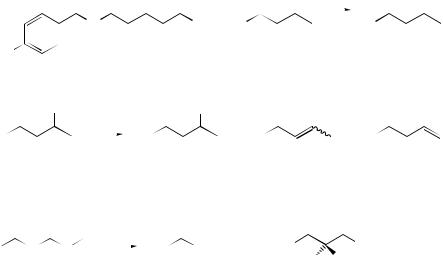
12 Elimination Reactions |
407 |
elimination of HF from β-fluoro ketone (62) in aqueous medium and without competing substitution.54 GluH50 acts as a general base at the active site; likewise, the antibody effects conversion of (64) to (66a) (18%), (66b) (72%), (67) (1%), and (65) (9%) by selective abstraction of the proton β- to the nitrophenyl ring. Reactions of the pentadeutero substrate (70) are subject to kinetic isotope effects of 2.9 and 4.1 for cis and trans elimination reactions, respectively. In contrast, GluH50 is believed to act as a general acid in catalysing hydrolysis of acetal (68) to the alcohol (69). The reactions share the nitrophenyl ring as a common recognition element and proton transfer as a mechanistic feature.
|
|
|
|
|
|
|
|
O |
|
F |
O |
|
O |
||||||
|
|
|
|
H+ |
|
|
|
|
|
|
|
|
|
|
|
||||
|
|
|
|
|
|
|
|
|
|
|
|
|
|
|
|||||
O2N |
|
|
|
N |
OH |
Ar |
|
|
|
|
Ar |
||||||||
|
|
|
|
|
|
||||||||||||||
|
|
|
|
|
|
|
|
|
|
|
|
|
|
|
|
|
|
|
|
|
|
|
|
|
|
|
|
|
|
|
|
|
|
|
|
|
|
|
|
|
|
|
|
(61) |
|
|
|
|
|
(62) |
|
|
(63) |
|
|
||||
|
|
Br |
|
|
|
|
|
|
|
OH |
|
|
|
|
|
|
|
|
|
Ar |
|
|
|
|
|
|
|
Ar |
|
+ Ar |
|
|
|
+ Ar |
|||||
|
|
|
|
|
|
|
|
|
|
|
|||||||||
|
(64) |
|
|
(65) |
|
|
(66) |
(67) |
|
|
|||||||||
|
|
|
|
|
|
|
|
|
|
|
|
|
a cis |
|
|
|
|
||
|
|
|
|
|
|
|
|
|
|
|
|
|
b trans |
|
|
|
|
||
|
|
|
|
|
|
|
|
|
|
|
|
|
|
|
|
Br |
|||
Ar |
O |
|
O |
|
|
|
|
Ar |
OH |
|
Ar |
|
CD3 |
||||||
|
|
|
|
|
|
||||||||||||||
|
|
|
|
|
|
|
|
|
|
|
|
|
|
|
D |
D |
|||
|
(68) |
|
|
(69) |
|
|
|
|
|
(70) |
|
|
|
||||||
π -Stacking interactions and solvation effects within the highly preorganized cleft of a bifunctional C-shaped host are believed to benefit the base-promoted conversion of 5-nitrobenzisoxazole to 2-cyano-5-nitrophenolate relative to the acetate-promoted reaction; structural variation of the host has been explored.55
Elimination Reactions in Synthesis
High-level quantum mechanical calculations have been used to explore the Horner–Wandsworth–Emmons reaction in the gas phase and also with a solvation contribution evaluated using the PCM/DIR method.56 Ring closure of the P−O bond (TS2), to form oxaphosphetane, is rate determining in the absence of solvation; however, the oxyanion becomes a true intermediate, at an energy minimum on the reaction path, only in response to the effects of solvation, whereupon its formation by carbonyl addition (TS1) becomes rate limiting. Formation of E-product is always

408 Organic Reaction Mechanisms 1998
favoured by TS2, whereas TS1 shifts the preference towards Z-selectivity if the phosphorus bears hydrogen-bond-donor ligands. The results emphasize the importance of addressing the relative stabilities of TS1 and TS2 in any interpretation of E/Z selectivities.
The ab initio MO(HF/3–21 G ) method and density functional (B3LPY/6–31 G ) theory have been used in higher level calculations for a range of oxaphosphetane reactions of MeCHO and PhCHO.57 For both non-stabilized (alkylidene) and semistabilized (benzylidene) ylides it has been found that cis and trans oxaphosphetanes are formed via puckered and nearly planar transition states, respectively. However, in contrast with previous semiempirical calculations and in agreement with known product distributions, the puckered transition state is found to be favoured by the latter, on reaction with benzaldehyde. For reaction between PhCHO and Ph3P=CHPh the computed carbonyl kinetic isotope effect (at HF/3–21 G ) is 1.051 at 0 ◦C and in agreement with the experimental KIE; in contrast, disagreement between the computed value (1.039) and the experimental value (1.0) for reaction with Ph3P=CHPr suggests that some rate-determining alternative to the puckered transition state may apply for formation of cis-oxaphosphetane from this non-stabilized ylide.
Ab initio (HF and MP2) and MNDO-PM3 theoretical studies of the reaction of unstabilized (Me3P=CHCH3), semi-stabilized (Me3P=CHC≡CH), and stabilized (Me3P=CHCN) ylides with acetaldehyde have also been reported.58 It has been concluded that oxaphosphetane formation proceeds by a very asynchronous cycloaddition (borderline two-step mechanism) in which the alignment of P, C, C, and O atoms is almost planar in the transition state; the extent of C−C bond formation ranges from 44% (unstabilized case) to 60% (stabilized case), whereas the degree of P−O bond formation is insignificant. Oxaphosphetane decomposition (retrocycloaddition) is also very asynchronous, with P−C bond breakage running ahead of C−O bond breakage. Unfortunately, the energy barriers calculated for the formation, pseudorotation, and decomposition of oxaphosphetane were very dependent on the level of theory employed.
Spectroscopic evidence for formation of a betaine lithium salt adduct during the course of a Wittig reaction has been reported for the first time.59 The ylide Ph3P=CH2 formed oxaphosphetane (71) on treatment with 2,2 -dipyridyl ketone at −60 ◦C in
P |
Li+ |
+ |
O− |
|
THF |
|
P |
Li+ |
|||||
O |
|
|
|
|||
N |
|
|
N |
|
||
|
|
|
|
|||
|
|
|
|
|
||
N |
|
|
N |
|
|
(71) |
(72) |
